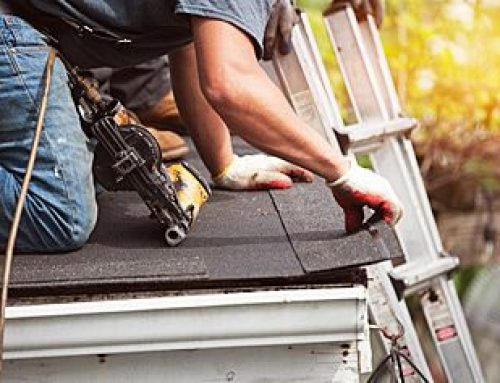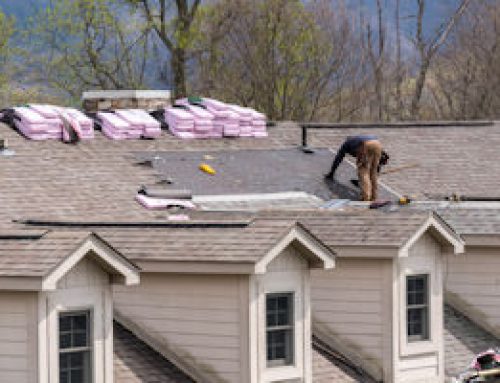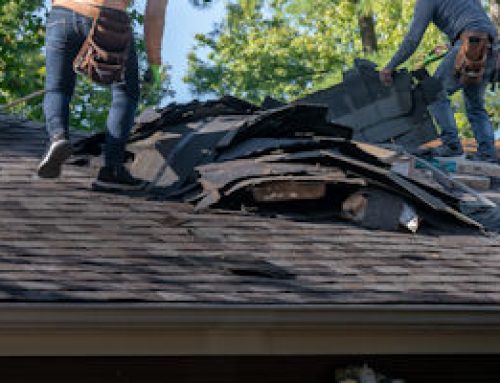Storms are the number one cause of roof damage in the lower 48 states. According to the National Severe Storm Laboratory, severe thunderstorms can generate heavy rain, hail, ice, and winds exceeding 100 mph.
This weather can dent or even puncture roofing materials, leading to leaks and other issues. About 33% of U.S. homes are at high risk of natural disasters and storm damage.
Texas is particularly prone to severe weather events such as thunderstorms, hailstorms, tornadoes, and hurricanes.
These storms cause significant damage to homes and buildings in the area, especially to the roofs.
Hail Damage
Hailstorms are most common in the spring and fall seasons. Hail roof damage is difficult to recognize, but the extent is determined by hailstone size, density, and point of impact.
The impact also depends on your roof’s materials and construction methods.
Slate and metal roofs are more robust and can survive hail damage better than wooden roofs or asphalt shingles.
Looking out for these signs can help you determine the degree of storm damage and figure out when to call a roofing contractor in Austin, TX.
Signs Your Roof Has Hail Damage
Loose, Cracked Shingles or Shingle Mat
Large hail can crack or loosen asphalt shingles. Even a small crack on asphalt shingles can change their look and function. Smaller hailstones can bruise shingles and push the granules further into the shingle surface making them more prone to severe damage with the next storm.
Dark or Black Spots on Your Roof
Hard hail can knock off the granules from asphalt shingles, leaving the roof with bare spots. From ground level, this can appear like darker or shiny spots on the roof. Exposing the asphalt coating to the elements accelerates the aging of the roof. Hail can also bruise the shingles, making them feel softer.
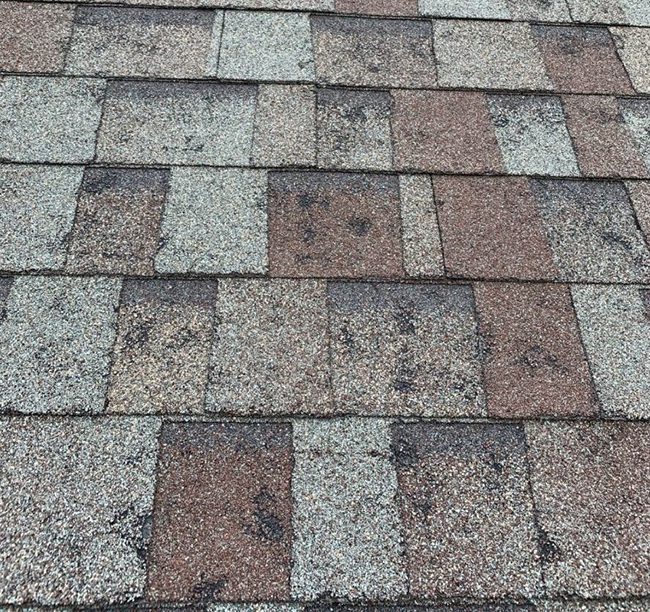
Dented Metal Flashing, Roof Vents, Gutters, or Downspouts
Depending on the severity of the storm, hailstones can hit hard on the roof surface causing dents in the surface. Metal flashing, roof vents, and the gutter system are particularly susceptible to denting and bending from strong hail. Some types of metal roofing can be susceptible to denting, depending on the thickness and type of metal.
Exposed Fiberglass
Strong hail on vulnerable roofing can shatter shingles and break them away from the fiberglass mat underneath. If you can see any exposed fiberglass, your roof is at risk of major leaks into your home.
Wind Damage
Wind damage is caused by strong winds blowing at high speed. When high winds hit, it doesn’t simply flow evenly across the surface, it can whip and turn and swirl around the corners, the edges, and the ridge line to create significant damage.
High-strength winds that follow a storm can throw trees and debris against your roof causing extensive roof damage. The storm damage is usually apparent instantly but some signs are more subtle.
Signs Your Roof Has High Wind Damage
Missing or Loose Asphalt Shingles
Strong winds can often lift shingles, loosening them and causing the loss of entire shingles. If you can see obvious bare spots on your roof, this is a clear sign. However – your shingles may be loosened significantly, but not missing. A roof inspection will ensure that any loose shingles are fastened securely before the next storm.
Curled, or Lifted Edge of the Roof
Roof edges and high-stress points such as flashings around the chimney are most likely to sustain wind damage. You can often see storm damage in these areas from ground level. Look for edges that are curled up or lifted after strong storms.
Tree Limbs or Downed Power Lines on Your Roof
Falling objects such as trees and downed power lines are a major headache after strong storms. This type of large-scale destruction can cause small cracks or large holes in your roof. Tree branches may also break off and cause damage to previously loose or vulnerable shingles.
Punctures From Debris
Strong winds pick up anything in their path. The stronger the wind, the more it carries. You may find trampolines, trash cans, toys, or debris that can puncture your roof causing extensive storm damage.
Rain Damage
Water damage is a common issue that often accompanies severe storms. It may be from melted hailstones or rain.
Typically, rainstorms shouldn’t be a problem for your roof unless you experience heavy or prolonged rain, or your roof is already compromised or damaged.
If rainwater can’t drain, or drain fast enough, it will slowly erode roofing materials and lead to storm damage.
Signs Your Roof Has Rain Damage
Granules Washed Down into the Gutters
When it rains, check your gutters and your downspouts. If you see black granules building up, it could be erosion from your shingles. Rainwater often sweeps blown-off granules down the drain, which can quickly clog up your gutters and leave your roof exposed.
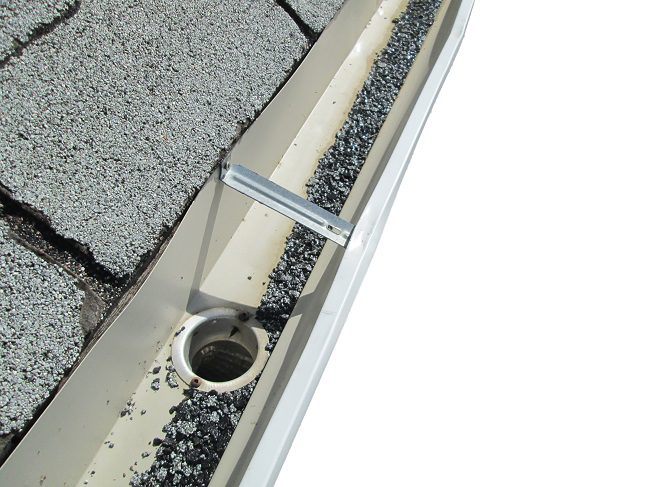
Pooled Water
With heavy rain, your roof can trap moisture in the eaves or low areas where there’s an improperly functioning drainage system. This pooling water can cause major damage to your roofing materials underneath.
Visible Growth of Mold or Mildew
If your roof has cracks and crevices, this creates the ideal place for mold to grow, causing mildew, expansion of materials, and deterioration of the wood on your roof. Mold also brings an infestation of bugs and other debris.
Leaking Roof or Ceiling
Over time, storm damage combined with extreme temperature fluctuations can beat up your roof and leave it vulnerable to leaking moisture. This can cause leaks, water spots on the ceilings, and dampness on interior walls.
Clogged Gutters and Downpipes
Clogged gutters can force heavy water to flow back over the top of your roof’s surface with nowhere else to go. During heavy rains, this creates standing water on your roofline, causing damage to the shingles and wood.
Snow and Ice Damage
Typically, snow melts off your roof easily. But, heavy snow or ice can exacerbate underlying leaks and expose your roof to moisture. If you experience sudden or consistent snowfall (rare in San Antonio, but possible) the accumulation of snow may add weight to your roof which can cause significant storm damage.
Signs Your Roof Has Snow and Ice Damage
Ice Dams
Ice dams occur when moisture or heat cannot escape through the attic ventilation. A dam of ice may appear on roof edges, and spill over into the gutters. Ice dams put pressure on shingles causing cracking, movement, and separation from the underlayment.
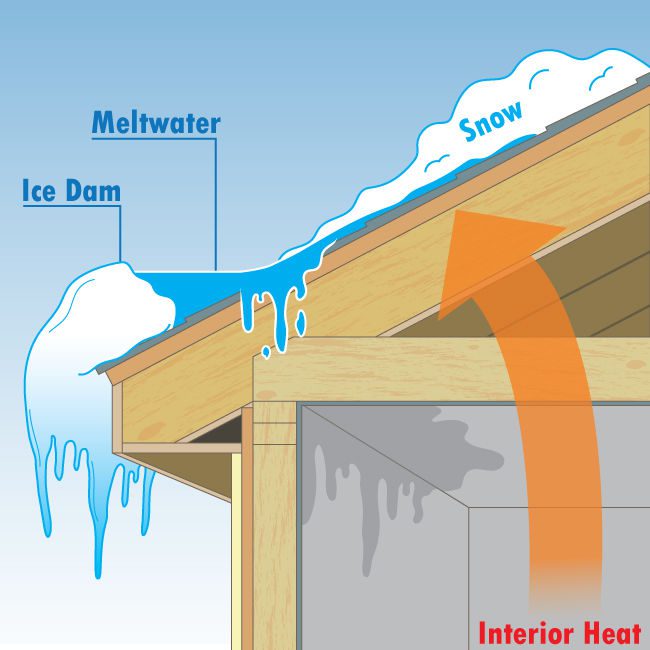
Snow Associated Leaks
If you have even hairline cracks in your roofing materials, snow can seep inside and cause leaks. This presence of moisture can also melt and soak insulation and ceilings, leading to mold and severe water damage in the home.
Collapsed Gutters and Roofs
Sometimes with extreme temperature fluctuations, water may freeze and thaw multiple times for several days. If this occurs, it may cause gutter damage causing sections of your gutter system to disconnect from your roof.
A Sagging Roof Deck or Cracks in the Ceilings
Because the presence of major snow is so rare in Texas, the homes are typically not built with reinforced beams to handle the weight of heavy snowfall. While this scenario is unlikely, the weight of excessive snow in the area can rip shingles, bend supports, and ruin your roof’s overall structural integrity.
Leaks in the Gutters
As snow and ice melt, the moisture runs down to the gutters. If it freezes during this process, it may cause a blockage and start forcing moisture back up onto the roof. This process may trap water under a layer of ice and can damage roofing materials.
What To Do After a Storm
After the dust has settled and the storm has cleared, it’s time to evaluate any damage to your roof.
Start with the following steps as soon as possible:
How To Protect Your Home from Storm Damage
While storms are unavoidable, you can minimize the amount of impact they have on your roof by:
- Regularly Trim Your Trees
Loosely hanging tree limbs are a recipe for disaster when a storm hits. They can quickly cause damage to your roof and home. Check the trees in your yard to ensure they’re secure and schedule regular trimming to protect your property.
- Seal Your Doors and Windows Properly
A small opening in your windows or doors is enough for strong winds to cause catastrophic storm damage to your roof and the entire home. Ensure your doors and windows are properly sealed.
- Clear Your Gutters
Clearing your gutters keeps gutters free-flowing and the downspouts drain water away from your home’s foundation. Water damage and foundation issues from strong storms can damage your property and devalue your home.
- Check for Loose Fence Posts
Strong winds will blow away anything that’s not secured, including fence posts. To check your fence’s footing and identify loose posts, shake each post strongly. If you have any that can easily wiggle out – make sure you secure them as soon as possible.
- Repair Loose Siding and Replace Missing or Damaged Shingles
Any unrepaired damage can get worse and cause bigger problems. Don’t delay getting roof repair services for your home’s roof. Leaving even small issues unattended can cause more damage later.
- Use Storm-Resistant Materials for Your Roof
Depending on your geographical location and the frequency of storms in your area, you may need to consider upgrading your roof with more storm-resistant materials. Consider selecting materials that are designed for your area and are more resistant to high winds, hail, and rain.
Insurance Coverage for Storm Damage
Storm damage is considered an Act of God and thus liable for compensation under most homeowner’s insurance policies.
However, failing to file claims on time or poor documentation can make you ineligible for coverage, and increase your premium rate for subsequent disasters.
For your insurance to cover roof damage, the amount payable depends on:
- the extent of your damage
- the age and structure of the building
- your premiums and deductibles
- property values in your neighborhood
Let Prime Seamless Protect Your Home From Storm Damage
If you suspect that your roof has been damaged in a storm, it is important to have it inspected by a professional roofing contractor as soon as possible. They can assess the extent of the damage, provide recommendations for repairs or replacement, and even work with your insurance company to file a claim and settle payment options.
If you are concerned about past storm damage, or want to protect your roof from future storms, give us a call.
Prime Seamless is an expert in residential roofing to keep you and your family protected when it matters most.

